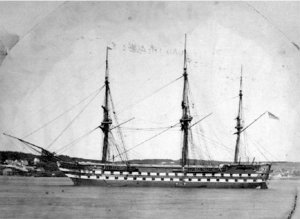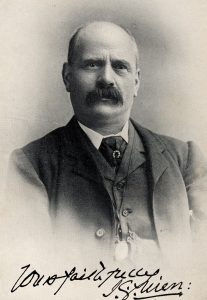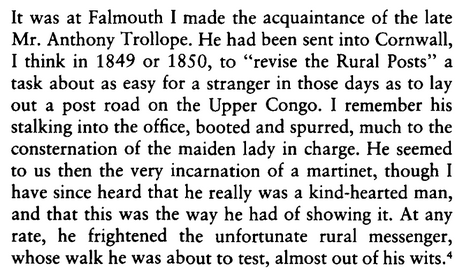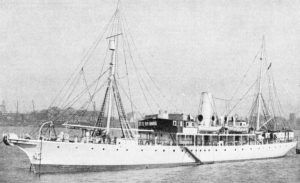In my last post I outlined (briefly!) my mother’s family history in the Scilly Islands. In this post, I want to set the stage for my most illustrious ancestor, John George (JG) Uren, and his relationship to the islands. JG (seated center in the picture above) was born in 1834 in Budock Parish, south of Falmouth. His parents were Joseph Uren and Carolyn Barwis. The Barwis family was prosperous, including some bankers in Penzance, and Joseph’s father-in-law ran a school in Penryn (Belle View) for young gentlemen.
Joseph Uren was apparently born in Falmouth in 1817. I say apparently because the records are a bit confusing. One Joseph was born in Penzance in 1811. Another in 1816 in  a town outside of Penzance. The Joseph I have chosen had parents Richard and Alice, living in Falmouth, and strangely enough, his grandmother Elizabeth was a Blackwell! Whoever the correct Uren is, he married Carolyn Barwis in 1834. Carolyn was two years older, and was the daughter of Benjamin Barwis, the owner of the Belle View school in Penryn. John joined the Royal Navy in 1834, the year he married. His Navy records show him as having been born in 1815, but I’m pretty sure that this is the same Joseph restating his age to qualify as an adult. He served for more than 20 years, and is shown in the 1861 census as on board the HMS Ganges (picture above), as a Yeoman Signaler. Re-constructing his service, I believe that he spent time in the West Indies, in the Mediterranean based in Malta, in the Black Sea after the Crimean War, and finished out on the Ganges based out of Valparaiso, Chile. He then shows up with Carolyn in Falmouth until his death in 1898.
a town outside of Penzance. The Joseph I have chosen had parents Richard and Alice, living in Falmouth, and strangely enough, his grandmother Elizabeth was a Blackwell! Whoever the correct Uren is, he married Carolyn Barwis in 1834. Carolyn was two years older, and was the daughter of Benjamin Barwis, the owner of the Belle View school in Penryn. John joined the Royal Navy in 1834, the year he married. His Navy records show him as having been born in 1815, but I’m pretty sure that this is the same Joseph restating his age to qualify as an adult. He served for more than 20 years, and is shown in the 1861 census as on board the HMS Ganges (picture above), as a Yeoman Signaler. Re-constructing his service, I believe that he spent time in the West Indies, in the Mediterranean based in Malta, in the Black Sea after the Crimean War, and finished out on the Ganges based out of Valparaiso, Chile. He then shows up with Carolyn in Falmouth until his death in 1898.
I would love to know more about Carolyn. Her dates are mysterious, as is her having married Joseph, who must have been a social inferior. I was able to follow her in 1841, 1851 and 1861 census records. In 1841 she was living in Budock parish; in 1851 she shows up living with her mother Sarah in Falmouth; in 1861 again in Falmouth, this time in the mixed household identified as a Seaman’s wife; several other residents were milliners including her daughter. This would have been very near the end of Joseph’s time in the Navy, and census records starting in 1871 show Carolyn residing with John, who is identified as a retired seaman.
John George (JG) Uren, son of Joseph and Carolyn, was born in 1834, suspiciously close to  his parents’ wedding date. I know little about his early life except that he attended the school owned by his family (the Belle View mentioned above), as shown in a short bio printed later. Following school, and after starting as a postal clerk in Falmouth around 1850, JG had a distinguished career with the Post Office, serving in various locations in Cornwall, followed by time in Constantinople, and then advancing after various assignments to Postmaster of Penzance. As Postmaster he wrote and testified about various postal and maritime matters, and served as well as a member of the Penzance Natural History Society.
his parents’ wedding date. I know little about his early life except that he attended the school owned by his family (the Belle View mentioned above), as shown in a short bio printed later. Following school, and after starting as a postal clerk in Falmouth around 1850, JG had a distinguished career with the Post Office, serving in various locations in Cornwall, followed by time in Constantinople, and then advancing after various assignments to Postmaster of Penzance. As Postmaster he wrote and testified about various postal and maritime matters, and served as well as a member of the Penzance Natural History Society.
At some point in his early postal assignments he bumped into Anthony Trollope, who, when not writing, also worked for the Postal Service. Here is an excerpt from an article in Blackfriars magazine in 1894 , where JG is quoted.
JG’s chief claim to fame is his authoring of a (the?) classic book regarding the Scilly Islands, Scilly and the Scillonians, published in 1907. If you do a Google search on Scilly, his book comes up repeatedly, and it is still quoted. JG came to write the book as a result of his work assisting in the laying of the first telegraph cable from the mainland to the islands, and subsequent work creating and developing the post office there. I can’t possibly capture the spirit of this quirky book here. It combines an extensive review of the geography, economy, and history of the islands with a collection of very entertaining maritime anecdotes. JG loved sea stories. I have included one as a separate post.
Over the years, he clearly developed a deep relationship with the islands. His son, George Gilbert, who is my great grandfather, met and married an island girl, Ethel Edwards. I will describe him in a later post.
A brief word regarding just how important the Postal Service was to the Empire. I knew from the bio mentioned above that JG spent time in Constantinople. As I looked into the Post Office there, I discovered a bunch of books about it, and slowly came to realize that following the Crimean War, and as the Brits and Russia engaged in the “Great Game”, Constantinople would of course have been a key communications hub. I can’t find any mention of JG in any of these materials, but his going abroad fits in with the picture I am drawing of the efforts of those generations of Brits who built the empire. You can access material about this fascinating period here.
Researching JG and GG, I got sucked down another fascinating rabbit hole regarding the laying of telegraphy cables in the period from 1860 to 1920 or so. There are several good summaries of the history, including this one. In his book, JG describes the political machinations in the British Parliament to fund the earliest efforts to the off islands (Guernsey, etc.), and has a very entertaining chapter about the laying of the first cable to Scilly. Apparently, the government contract required very rapid installation, followed by proof of function. The engineer in charge of laying the cable had miscalculated the distance, and ran out of cable somewhat short of Scilly. So what to do? Well, he dropped the cable end, went to Scilly, and conducted a completely bogus demo based on his having memorized the test message. They did later complete the cable, but it was never a successful business venture.
The British were the most active parties in pursuing this new technology  internationally. The early cables themselves were fabricated in facilities in and around London, which eventually adopted a multi-layer design using gutta percha as the protective outer layer surrounding the actual cable components. Once laid, things sometimes went awry. The story quoted from his book in a separate post occurred when JG was a cable inspector looking for a break off of Lands End. A typical cable ship of the period is shown to the right. I will have more to say about telegraphy cables in the Far East in my post about GG Wren, my great-grandfather.
internationally. The early cables themselves were fabricated in facilities in and around London, which eventually adopted a multi-layer design using gutta percha as the protective outer layer surrounding the actual cable components. Once laid, things sometimes went awry. The story quoted from his book in a separate post occurred when JG was a cable inspector looking for a break off of Lands End. A typical cable ship of the period is shown to the right. I will have more to say about telegraphy cables in the Far East in my post about GG Wren, my great-grandfather.
JG and his wife Mary Tregoning had 8 children, four sons and four daughters. I will briefly describe one of his sons before I move on. Charles Joseph was the first child, born in 1861. As described in Five Thousand Miles in a Sledge (available on Google books) by Lionel F Gowing, Charles had been working for the Eastern Extension Telegraph Company out of Shanghai, when in 1885 he and his friend Mr Gowing decided that they should take an alternate route back to England, namely by sledge through Siberia, with Lionel to write the book, and Charles to do the illustrations. One of his illustrations is shown here.
“Mr. Uren, of the Eastern Extension Telegraph Company, though by no means an old resident, was strongly imbued with this unpatriotic notion . ‘ England, ‘ he was wont to declare, ‘ is a capital country to live out of and boast about ; ‘ but even he had sufficient love for his native land to look forward with eager anticipation to a coming twelvemonth’s furlough, which would enable him to pay a temporary visit to Old England. For my part, I had determined , after a four years’ residence in Shanghai, to break through the fascinations of Far Eastern life before they obtained too strong a hold on me ; and on this sultry August day in 1885 we were discussing the respective merits of the various routes from China to England. My future comrade declared that he had for some time entertained the idea of making his way home through Siberia in the middle of winter, but unfortunately he had never been able to find anyone mad enough to accompany him, and he had consequently abandoned the notion. I at once stepped into the breach, and within five minutes the journey was, in our minds, an accomplished fact.”
What could go wrong? Well, you have to read the book, but unfortunately, by chapter 15, Mr Uren has succumbed to TB. He got as far as Moscow, and of course Mr Gowing got home and wrote his book. The sketches of 19th century “Corea” and Russia are really very interesting. You can find the book in Google books.
And with Charles, I close this post. Next we turn to my great grandfather, George Gilbert Wren, and my grandfather, another JG.

Fascinating. I presume you have visited PK Porthcurno to see the telegraph Museum there? They have an extensive archive.
It’s on my list! I was completely unaware of the rich history of telegraphy in England. It reminds me of Silicon Valley. I have not looked at on-line resources at the museum, but will do so right away. Thanks for the tip!